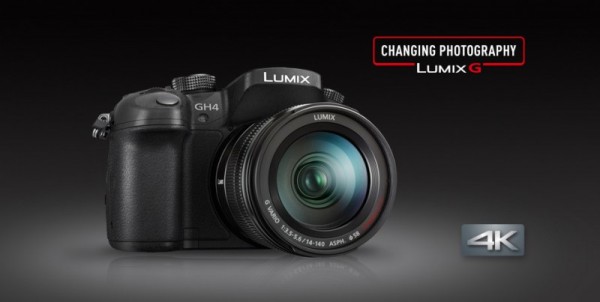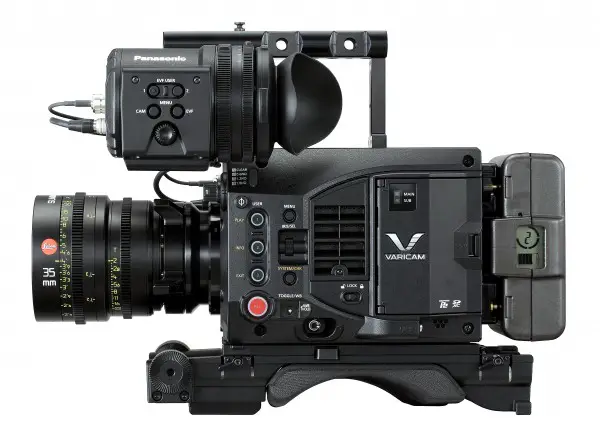The Panasonic GH4 is two years old now and by today’s camera standards a model refresh is imminent in 2016. Supposedly the next GH camera from Panasonic namely the GH5 or whatever it ends up being called – may potentially feature video recording in the staggering 6K resolution from a new 20 Megapixel sensor as well as 4K/60p according to Japanese website Nikkan. There are a few big trade shows coming up – NAB in Las Vegas in mid April, which is more geared towards professional broadcast equipment, so a GH5 unveil in Nevada is not very likely. However, Photokina in Cologne, Germany in early Fall is a stills camera and lens-centric bi-annual event, I’d say there is a very good chance Panasonic may chose to unveil their new GH5 there.

A photo-chopped GH5
The report by Nikkan, goes on to say that users can extract 18 Megapixel images out of the 6K video stream. Whether this is true or not is yet to be seen, and we’ll have to wait a few more months until September, but for those of you who already own a GH4 (I used to be one of you) you may want to keep a hold of your camera for some time. And here is what I mean by that.
Even if this rumour turns out to be true, which I doubt, the increase in resolution from 4K to 6K would be a marginal improvement. Combine this with non-existent 6K monitors and also with the fact that most likely there will be either a heavily compressed H.264 based codec or the new H.265 implementation, which is quite the hog when it comes to editing the footage and you’d have to resort to transcoding into ProRes/DNxHD again.

Moving from 1080p to 4K is a significant improvement in image quality if done right and seen on a proper monitor, but given that most deliverables from a GH5 would end up back on the web, I don’t really see a lot of benefits of any resolution higher than 4K. Sure, there is talk of 4K/60p but no one seems to talk about the inevitable and unavoidable by-product of image capture at such resolutions that that is – heat! Remember the Sony A7sII/A7RII overheating issues upon release?
Yes, the Canon XC10 can shoot in UHD in a really nice XF-AVC 8bit 422 codec at 305Mbps which produces lovely images that are very grade-able, but it has a small fan on the back and as Canon head honchos have stated in multiple interviews – battling heat dissipation from extra load place on image processors and sensors when capturing in higher resolutions for video is a major issue – one that I think Canon have cleverly fixed on their cameras. The C300 II is silent and so is the XC10, but they both have vents and fans inside. There is built in real estate for those.
The new Canon 1D X Mark II can do 4K/60p in 8bit 422 Motion JPEG, which is a beast of a codec that is nearly impossible to edit unless transcoded to something more friendly, but the 1DX II is a beast of a camera – it’s full frame, bulky and beefy with some serious horsepower inside. And it costs 6 grand!

When you think how big the current Panasonic GH4 model is, for Panasonic to fit a fan in there – that would add some bulk to the new body. And keeping things more compact is one of the main benefits of shooting Micro Four Thirds. And speaking of MFT – there is a lot of talk of the GH5 possibly moving up to APS-C or even (God help us) full-frame.
My issue with this logic is – what is Panasonic going to sell you for lenses for this new full-frame camera? They have none, they are so vested in the Micro Four Thirds world that moving up would not be a very wise business decision as they will be handing over the competition a big chunk of their business as users would be forced to buy lenses from Sigma, Canon, Nikon and Sony. Sure, most MFT lenses excluding the widest ones would probably cover some variant of an APS-C/S35 sensor, but it will still be a big gamble and result in a larger camera, which is not really very appealing.

And to all those who want a 10bit 422 internal recording in ProRes in the GH5 – as much as I’d love to see it happening – I think it won’t. Panasonic have just announced their Varicam LT in order to appeal to the mid-level pro shooters who have about 20 grand to spare on a new pro digital cinema camera, which does feature ProRes internal recording.
The way things stand right now – there is nothing between the DVX200 and the LT – a void that is more likely to be filled by an AF101 successor (surely hope so at NAB) with 10bit internal recording in either AVC-Intra or ProRes rather than a prosumer camera that is targeting predominantly enthusiasts rather than video professionals who require 10bit recording for either broadcast or corporate/commercial work.
I really want the GH5 to be great, there is a lot of expectation for it and it has big shoes to fill as the GH4 is still an awesome and very capable camera. However, I prefer to keep my expectations within reason – I’d rather get a new, better MFT Sensor with better DR and low-light performance, rather than 6K resolution. But that’s just me. What do you guys think?
[via 43rumors]
Disclaimer: As an Amazon Associate partner and participant in B&H and other affiliate programmes, we earn a small comission from each purchase made through the affiliate links listed above at no additional cost to you.




I think 6k is too much but a 4.6k resolution like the Ursa mini is ideal to use software stabilization like Innertiacam without lowering the output resolution under the UHD specification. In the other hand, more dynamic range and a 12-14 bit raw or al least 10 bit 422 pro res internal would be very welcome.
I can see 6K, as Panasonic has been eager to push the hybrid stills-from-video approach. I think a lot of stills shooters have been hesitant to go back to 8MP JPEGs, but this bump in resolution could make it more appealing. Larger sensor though, no, not in the GH series. It would more likely be Panasonic’s version of the Leica SL. New line, new lenses to sell. They will have an uphill battle going against Sony in this market though, as will everyone else.
6k is a cool headline feature even though most won’t be able to make good use of it. 4k 60p would be a practical improvement. most of all i want to see better low light, better slow mo, and 10 bit if possible.
I don’t care for 6k. I just want 4k with less noise and possibly raw or prores 1080
I feel that the 6K data is so huge that it will be impossible to work with store and manage. I am not saying I don’t want the option it will find its place.
I’d settle for improved low light however 6k would be very useful. I’m normally a single-camera shooter so being able to crop my footage and still deliver full rez 1080p/4k would be fantastic. Also stabilising footage would benefit too by shooting slightly wider so when it’s cropped, again no quality loss.
6K, yes, as a professional video that would be helpful, better dynamic range, yes again, in a color grade situation that would terrific.
Low light, no too concerned about this, base ISO 1250-1800 would great, I am able to light my subjects and have general control of my lighting. Better codec, ProRes can be noisy, files rather large with little benefit. I have found the higher Rez and internal codec with the GH4 to be rather good, good enough to key with along with my Sony F55. What I would like to see is a small cube, where I can add my viewfinder/monitor, xlr module, GH4/AF100 batteries with the GH4/5 internals…
I have to disagree with you, 6K is very useful for getting a perfect 4K image with less noise, better detail, better colors and bigger DR after re-sizing + it will make a much easy for stabilizing and re-framing.
I personally don’t like the Mjpg codecs at all, they are very inefficient and add unnecessary cost to production by needing much more recording and storage space.
I generally agree with your points. If I had a wish list for the next Panasonic camera. it’d have to include:
1) Better low-light performance/wider range. Panasonic’s consumer-grade camcorders are great at this, so why not their higher-end cameras?
2) A slow-motion mode in 4K. I’d be happy with 60p.
3) 10-bit internal recording– or, alternatively, a cheap 10-bit-capable external recorder, perhaps with a YAGH-link form factor. It’d make use of those connectors at the bottom and avoid worn HDMI ports. (Maybe they can make it to accomodate 15mm rods.)
4) Reliablity. (I had a strange problem on a recent shoot, where horizontal “bars” appeared briefly in my footage for a second or two. They weren’t banding artifacts: just a strange set of slightly-discolored horizontal regions that moved up slightly before disappearing. Might’ve been a V-log problem. I hope this is something Panasonic can fix in the next firmware.)
6K is the prosumer marketing point, they already know that most who buy in will end up in 4k and have even sharper 1080p video-y footage they can post online
You don’t see a need for anything above 4K? You’re thinking small scale here, sure 6K will result in much more data, but 6K helps future proof your work. No we don’t have 6K monitors, but the extra resolution can lead to a cleaner and sharper 4K image when downsized, and gives you more options on the editing floor. Need to make that medium a close up? Punch in. You can also do the Fincher method of reframing in post. 6K isn’t vital per se, but to limit yourself to 4K because it’s good enough is dumb.
I’m sitting here with cash in hand looking to upgrade my existing Canon kit for a real 4k workflow.
Sony – wtf is wrong with them that they put the flipout display to flip down where it is obscured by a tripod? I use the flipout screen on my 70D on 95% of all shoots. Around 40% of them from the side. I also sometimes find that nervous speakers can feel more at ease if someone is beside the camera rather than behind it.
So checking out Panasonic instead.
#1 on my list of needs for 2016-2018 will be 4k60, maybe 1080p120 or better.
#2 – *must* have a side-viewable flipout screen
All the rest of it is good, but not critical.
Things I don’t care about:
#1 – I do all my audio off-camera and record scratch audio only in camera or backup audio in some cases
#2 – creating 4k output video files. I realize that some people will need this, but my content is published to YT and 1080p will really be good enough for 95% of users at least until 2018. Currently <1% of my views are in full screen on a 4k device. For artistic works, that's fine, but I do commercial production videos. 3 years from now, the videos themselves will no longer be relevant. Future proofing is a non-issue for product that will only remain on the market for 5 years.
I would *love* to see a quality adaptor to use my extensive set of Canon glass on a Pana body. I'd have 2 GH4's right now if that was a reality. It's not, so I don't. Yeah, I do the lazy way and do a lot of automatic focus pulling and automatic rack focus pulls too. I shoot a lot of quick and dirty stuff and my eyes aren't what they used to be.
For now, there's just no sensible option for me, so I remain using my Canon 70D + Hero4 for the 2016 shooting season. And I'm not at all happy about that.
Pana, Sony, get your act together!
I'm not saying they have to build to my specifications. I'm saying that my needs are very common realistic needs. And those needs are not met by these models. Yeah, I need smooth creamy video. Yeah I want the dynamic range that is now become commonplace. But more than that, I need to actually shoot the footage too. If the camera makes that impossible/impractical, I don't buy the camera. Simple as that. I can't be the only one who uses flipout screens that can be usable from the front and the back as well as the side. They are pretty much standard equipment on… every camcorder in the past 15 years… While I'd love to say that I'm a big pro with a big pro rig on tracks with a guy to push it around and a chassis with 15 different acessories mounted, the reality is that a lot of production video is being made with small rigs right now. A lot of guys that I know that do freelance production use small rigs for most of their work.
Wishlist in order of importance:
— Better low-light performance by whatever means
— In-body image stabilization
— 4K at 200mbps
— 4K in 10 bit 4:2:2
— 4K at 60fps
— On-screen LUT for VLOG recording
— Higher resolution LCD
— Cleaner mic input
— More customizable buttons
— Ditch the built-in flash
These are what I need from the new GH5 why is there a flash on this camera?
The most helpful improvements for me would be:
+ much better highlight rolloff (this is very bad on the gh4) .. better dynamic range
+ 422 internal recording (internal 10bit would be the best but I think this isn’t a real wish)
+ internal stabilizer
+ a better V-Log that uses the full range of the possible 8 or 10bit
+ more sturdily HDMI output socket
+ On-screen LUT for VLOG recording
+ 6K for super35mm and 4K for MFT
+ better lowlight performance until ISO 1250-1800
I’m happy with the 4k, …. However, better low light performance, increased DR, better HDMI + lock system? IBS, ….. YES! I have to tripod most of my GH4 footage however, my EM5-MkII is sooo smooth with it’s IBS I can shoot a lot handheld.
I think the GH4 is a very, very good camera in it’s current configuration.
My above wishes would simply bring it closer to perfection.
If the new GH-5 has IBS, … I expect I will invest in a body.
Extreme resolutions don’t matter all that much i mean its obsolete anyway as fast as a new camera is launched, 4K or 4.6K should do it. A nice 5 axis stabilisation and some improvements on high ISO would be much more welcome. Also the ability to gain some stops of light and a faster and more usable autofocus would be nice
.